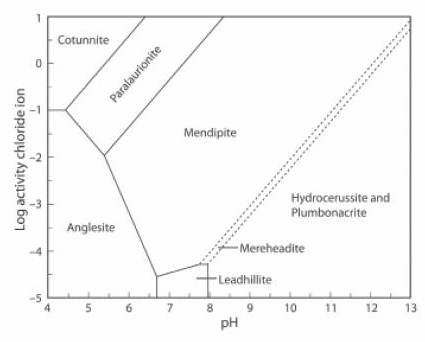Localities
There are two co-type localities, the Torr Works quarry (Merehead quarry), Cranmore, Mendip, Somerset, England, UK, and Wanlockhead, Dumfries and Galloway, Scotland, UK.
At the Torr Works quarry plumbonacrite occurs in association with mereheadite and rickturnerite. It forms crystals to around 4 mm with occasional larger composite clusters. It's stability field is very limited, and a pH of around 13 must have existed in the deposits when the plumbonacrite was formed. To date (2010), plumbonacrite has been found only as euhedral crystals enclosed in either mereheadite or rickturnerite, so presumably it formed early on, in extremely alkaline conditions (JRS 13.32).
Plumbonacrite from the Torr Works Quarry - Image
At the Mammoth-Saint Anthony Mine, St. Anthony deposit, Tiger, Mammoth Mining District, Pinal county, Arizona, USA, plumbonacrite is associated with anglesite, linarite and galena (HOM).
Stability
The Activity-pH diagram below was calculated for some lead minerals. Boundaries are calculated for constant activity (roughly equivalent to concentration) of (SO4)2- and constant partial pressure (also roughly equivalent to concentration) of CO2, over a range of values of pH and of Cl1- activity. Here the concentration of CO2 is close to zero, at about 0.01% of the atmospheric value
Cerussite does not form in these conditions, the stability field of mendipite is very large, and mereheadite and plumbonacrite can form, although they are not stable at higher levels of concentration of CO2 (JRS 15.18-23).

The lead mineral formulae are:
cotunnite PbCl2
paralaurionite PbCl(OH)
mendipite Pb3O2Cl2
mereheadite Pb47O24(OH)13cl25(BO3)2(CO3)
hydrocerussite Pb3(CO3)2(OH)2
plumbonacrite Pb5(CO3)3O(OH)2
anglesite Pb(SO4)
leadhillite Pb4(CO3)2(OH)2
Back to Minerals